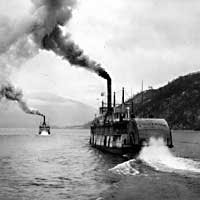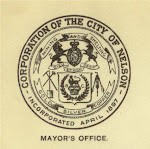One of these talented men and the most prolific, Alexander Carrie, designed a structure that has been the anchor of Baker Street since its completion in 1900. Stand anywhere on Baker Street and your eyes are drawn to that most distinctive turret at the very centre of our city. Unbeknown to many is the fact that at one time there were four turrets at this very cross street and only the Kirkpatrick Wilson Clements Block has withstood the test of time.
By 1900 the shantytown that became the City of Nelson was gaining in respectability. The Ward Creek gorge that bisected Baker Street had been filled in and the stage was set. With budding entrepreneurial spirit large stone and brick edifices were being constructed and the southwest corner of Baker and Ward Streets was not immune.
 According to the Nelson Daily Miner the Bank of Montreal had cast covetous eyes on Lot 10 of Block 10. They had recently retained architect Francis Rattenbury to draw plans for a new bank and this corner was perfect. Mr. Rattenbury attended at Nelson and announced that he did not believe, with the proximity of Ward Creek, that foundations could be constructed that would adequately support his building. With that the Bank of Montreal “swapped Titles” with the owner of the lots of the present day site of the bank.
According to the Nelson Daily Miner the Bank of Montreal had cast covetous eyes on Lot 10 of Block 10. They had recently retained architect Francis Rattenbury to draw plans for a new bank and this corner was perfect. Mr. Rattenbury attended at Nelson and announced that he did not believe, with the proximity of Ward Creek, that foundations could be constructed that would adequately support his building. With that the Bank of Montreal “swapped Titles” with the owner of the lots of the present day site of the bank. However, “swapped” is not quite accurate. The activity on this corner allows for a brief glimpse into land speculation in early Nelson.

On April 04, 1899 the Bank of Montreal sold Lot 10 to Frank Fletcher (left) and Arthur E. Hodgins (lower right) for the sum of $10,000. Frank Fletcher purchased the share of Arthur E. Hodgins on March 5, 1900 for the sum of $1,000 and on the same day sold Lot 10 to Austin Henry Clements for the sum of $10,500.00!

On April 04, 1899 the Bank of Montreal sold Lot 10 to Frank Fletcher (left) and Arthur E. Hodgins (lower right) for the sum of $10,000. Frank Fletcher purchased the share of Arthur E. Hodgins on March 5, 1900 for the sum of $1,000 and on the same day sold Lot 10 to Austin Henry Clements for the sum of $10,500.00!
On June 25 1900 A. H. Clements purchased an equal share of Lot 9 from John Andrew Kirkpatrick (below Fletcher left) and Charles J. Wilson for the sum of $1.00. Prior to this sale the Title had changed hands ten times since 1891! On June 30, 1900 J.A. Kirkpatrick and C.J. Wilson purchased an equal share of Lot 10 from A.H. Clements for the sum of $1.00.
The K.W.C. partnership was now on equal footing, the land was secure and both lots were consolidated into one holding. As an interesting aside, Charles J. Wilson was the Great Uncle of the Actress, Margot Kidder.
Partners were added and deleted over the next few years until the building was purchased by A. (Annie) MacDonald in 1905. This company, A. MacDonald and Company of Winnipeg, eventually became Canada Safeway Limited. A. MacDonald continued to hold Title until November 12, 1929 when the building was sold to the K.W.C. Company. This Company retained ownership until the sale to the present owners in 1973.
The corner store was to be occupied by the Canada Drug and Book Company, with the adjacent store, on Baker, the Kirkpatrick Wilson Company (Mercantile). The Ward Street frontage would house The Palm (Confectionary) and the West Kootenay Butcher Company. The main entrance would be on Baker Street. The estimated cost was $35,000.00!
On April 9, 1900 the work commenced. Just as today the use of local contractors was preferred and these were employed by Alexander Carrie. T.L. Bilderbeck was awarded the excavation contract; he estimated 3,700 yards of earth would have to be removed. Shackleton and Laidlaw supplied the masons. Their estimate for the foundations and Ward Street retaining wall was 1,000 yards of masonry. W.G. Gillette was awarded the general contracting; and the Lawrence Hardware Company would complete the steam heating, plumbing, gas fitting and sheet metal work. Pressed brick and terra cotta was to be supplied by Ernest Mansfield.
While the exterior of the building was nearing completion plans were made for the interior fittings. The Kirkpatrick Wilson Company would have fittings of the “latest model” of “native woods with mirrors placed at intervals.” The third floor had been leased by Mrs. F.J. Squire to furnish 28 rooms as “sleeping compartments” with “parlours” and “toilets.” Skylights and light wells were employed in the darker recesses.
 The second floor consisted of offices occupied by: Galliher and Wilson (Lawyers), The Prospectors Exchange, Drs. Hall and Rose (M.D.), Dr. Morrison (D.D.S.), Charles Waterman (Auctioneer), Arlington Mines of Erie, B.C., Graeb and McIntyre (Brokers), Ashnola Smelter Limited and the Similkameen Valley Coal Company.
The second floor consisted of offices occupied by: Galliher and Wilson (Lawyers), The Prospectors Exchange, Drs. Hall and Rose (M.D.), Dr. Morrison (D.D.S.), Charles Waterman (Auctioneer), Arlington Mines of Erie, B.C., Graeb and McIntyre (Brokers), Ashnola Smelter Limited and the Similkameen Valley Coal Company. The K.W.C. Block was the largest business block in the city and according to The Tribune one of the finest in the Province. It was completed at a cost of $42,500.00! The KWC Block, is visible in the photograph (above), middle left back, circa 1908.
Many will remember Mann’s Drug Store. Edward Mann was the nephew of William Rutherford, Druggist. Mr. Rutherford was with the Canada Drug and Book Company until he opened his own store in this same location. This store evolved into Mann’s Drugs. A drug store had been a constant in this one location for over 70 years. Edward Mann was responsible for placing the clock in the turret.
When Nelson was in an economic downturn Baker Street evidenced the loss. The street looked forlorn and in need of a face lift. With the Downtown Revitalization Project of the mid 1980s came a breath of fresh air and the rebirth of the Queen City - as well as the K.W.C.!
The K.W.C. Block today is assessed at over $1 million. It retains retail stores on the first level and private apartments on the second and third floors. Due to the plans of architect Carrie (right), the fine workmanship of the local contractors, the natural resources of the West Kootenay and the care of the present owners, the K.W.C. Block has not only withstood the test of time, it will be here long after we have passed.
1. Kinsella, W.P. Shoeless Joe. New York: Random House Publishing Group, 1996.
The historic photographs are courtesy of the Shawn Lamb Archives http://www.touchstonesnelson.ca/ .The K.W.C. Block image is the header of this blog. The photograph of Alexander Carrie, circa 1912, is courtesy of the Wallach Family.


